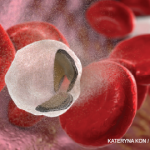ACR CONVERGENCE 2021—Hematologic abnormalities are common in systemic lupus erythematosus (SLE), whether due to SLE itself or something else. As rheumatology professionals, we are routinely challenged by the management of cytopenias in our SLE patients.
At the ACR’s annual meeting in 2021, two hematologists shared expert advice regarding common hematologic manifestations of SLE. Michael B. Streiff, MD, professor of medicine and pathology in the Division of Hematology at Johns Hopkins University School of Medicine, Baltimore, provided valuable insight into platelet and coagulation disorders in SLE. Nancy Berliner, MD, the H. Franklin Bunn professor of medicine and chief of the Division of Hematology, Brigham and Women’s Hospital, Boston, covered high-yield topics in anemia and neutropenia.
Thrombocytopenia
Dr. Streiff kicked off the session by explaining his approach to thrombocytopenia, a common feature of SLE. Platelet counts of less than 100,000/μL are seen in 10–25% of SLE patients. This is most commonly caused by lupus itself, immune thrombocytopenia (ITP) or antiphospholipid syndrome (APS).1

Dr. Streiff
Dr. Streiff outlined a stepwise approach to the treatment of a patient with SLE and low platelets:
Step 1: Identify the Cause
What is the time course of the platelet drop? “An acute drop might be caused by a new medication or illness, whereas a chronic progressive course has a different differential [diagnosis],” Dr. Streiff said.
Next, is this a production problem or a destruction problem? “Bumps with platelet transfusion mean this is probably a production issue, although bone marrow biopsy would be the gold standard to confirm that. An elevated immature platelet fraction (iPF) points to destruction,” Dr. Streiff said.
Step 2: Initiate Cause-Specific Therapy
“If the cause is SLE itself, treat the flare,” Dr. Streiff advised. “If ITP is suspected, immunosuppression is indicated. If the cause is an antiphospholipid antibody syndrome (APS) flare, optimize anticoagulation, confirm the patient is receiving hydroxychloroquine and treat catastrophic APS with additional therapies if needed.”
Immune Thrombocytopenia
When it comes to ITP, standard ITP therapies are effective when ITP is associated with lupus. Dr. Streiff noted the initial response rate to corticosteroids is excellent (up to 80%), but wanes over time and comes with a buffet of adverse effects. For severely low platelets, intravenous immunoglobulin (IVIG) is an effective addition to initial steroid therapy.2
“For steroid sparing [therapy], rituximab is my go-to [because] it works well and has a low side-effect profile. If rituximab isn’t successful, I look next to thrombopoietin (TPO) mimetics— eltrombopag or romiplostim. Both are also very effective, but I use them less in concomitant APS [because] rare thrombosis has been reported with both drugs. Third-line options include mycophenolate mofetil or azathioprine, but patience is necessary with these since they take two to three months to kick in. In refractory cases, splenectomy is another option,” he said.
Regarding platelet goals, Dr. Streiff counseled, “Remember that for immune thrombocytopenia, the goal is not to normalize the platelet count, but to get it in the 50–100,000/μL range to relieve symptoms and prevent low platelets from causing problems.”
Antiphospholipid Syndrome
Dr. Streiff then turned to APS, the most common primary coagulation disorder seen in SLE. “Thirty to 40% of SLE patients have antiphospholipid antibodies, and 20% of these have clinical significance,” Dr. Streiff explained. Clinical manifestations may include venous and arterial thromboembolism, obstetric complications, livedo reticularis, hemolytic anemia, valvular disease, microvascular disease (e.g., skin, renal, cardiac or pulmonary) and thrombocytopenia.3
As most of us know, the laboratory diagnosis of APS can prove challenging. “It’s important to remember that sample acquisition technique is of utmost importance when testing for APS, and obtaining a variety of tests, preferably off anticoagulation, is important,” Dr. Streiff said. “I recommend checking dilute Russell viper venom time (dRVVT) and activated partial thromboplastin time (aPTT) with a mixing study and confirmation step, as well as cardiolipin and beta-2-glycoprotein I antibodies—especially the IgG isotype. Of note, the presence of isolated anti-cardiolipin antibody and anti-beta-2-glycoprotein I IgA antibody is of unknown clinical significance, and the value of anti-phosphatidylserine antibody and anti-prothombin antibody testing remains unclear.”
What about refractory cases?4 “For recurrent thrombosis, my first step is confirming that the patient had a therapeutic international normalized ratio (INR) during the event and assessing for other risk factors like a vascular catheter,” Dr. Streiff said. “Next, I ensure correlation between the INR and chromogenic factor X (CFX) activity to confirm there isn’t a lupus anticoagulant causing the INR to be overestimated since this occurs in up to 20% of cases. Then I consider a higher INR target if necessary.”
Dr. Streiff took care to remind the audience of the importance of adjuncts to antithrombotic therapy: hydroxychloroquine and statins. Hydroxychloroquine has anti-inflammatory and anti-aggregatory properties that have been shown to reduce thrombosis and decrease titers of cardiolipin and anti-beta-2 glycoprotein I antibodies.5,6 “Hydroxychloroquine use is recommended, unless contraindicated [e.g., for patients with a drug allergy or confirmed retinal toxicity]. Recent studies also demonstrated that statins reduce the risk of venous thromboembolism and may also be considered,” he said.7
Dr. Streiff stressed that direct oral anticoagulants (DOACs) should still not be used in APS because studies to date have shown that recurrent thromboembolism risk is higher with DOACs than with warfarin.8 “The populations in these studies were high risk, but until [DOACs are] proven safe, I continue to recommend warfarin as the go-to drug for APS patients,” he said.
Anemia
Dr. Berliner took the stage next, reminding attendees that the most common causes of anemia in SLE are iron deficiency anemia (IDA) and anemia of chronic inflammation (ACI), alone or in combination. Autoimmune hemolytic anemia (AIHA), although often seen in SLE, is far less common.

Dr. Berliner
To distinguish IDA from ACI, Dr. Berliner looks first at ferritin levels. “Ferritin is an acute-phase reactant. But you shouldn’t be able to get a ferritin level over 100 in the setting of IDA,” she said. “Of note, long-standing ACI can cause IDA through hepcidin-induced failure of gastrointestinal iron absorption. If this is the case, iron repletion will be more effective if given intravenously,” she added.
When autoimmune hemolytic anemia (AIHA) is at play in SLE, it is almost always mediated by warm, complement-binding autoantibodies. “Diagnosis is straightforward in that the Coombs’ test will be positive, and the reticulocyte count will be high. Treatment includes steroids and/or rituximab,” she said.
Neutropenia
Dr. Berliner next discussed neutropenia, taking care to differentiate primary autoimmune neutropenia (which is antibody-mediated and primarily seen in children ages six to 12 months) from secondary autoimmune neutropenia (which is mainly seen in adults with underlying autoimmune disease). Dr. Berliner said, “Neutropenia is very common in SLE—nearly 50% of patients—and almost never requires specific therapy. Rather, it’s just a marker of underlying SLE disease activity with little impact on the course of the disease overall. In general, I use clinical symptoms to decide if something needs to be done, and they are virtually never there. Don’t treat the number. Look at the patient and see if they are having recurrent infections. Interestingly, infection risk correlates more with immunosuppression than the neutrophil count in SLE patients.”9
Dr. Berliner closed with a candid pearl: “I’m often asked if anti-neutrophil antibody testing should be sent. The problem with anti-neutrophil antibody testing is that there are many reasons for false positive results, correlation is poor and it’s very difficult to do these studies outside of highly skilled laboratories. So when do I check these in adults with neutropenia? Never.”
Regarding bone marrow biopsy, she said, “I would consider this if the patient had no evidence of active SLE, other counts were low and neutropenia was very severe.”
Macrophage Activation Syndrome
Macrophage activation syndrome (MAS) is a subset of hemophagocytic lymphohistiocytosis (HLH) in the setting of concomitant systemic autoimmune disease. It’s most commonly seen in children (in at least 10% of systemic juvenile idiopathic arthritis), but it’s not restricted to pediatrics.10
“MAS is a difficult diagnosis to make [because] it can be hard to differentiate from a flare of underlying disease,” Dr. Berliner said. “However, it appears to be much more immunoresponsive than other forms of HLH, and you almost never need etoposide or transplant. Treatment of the underlying disease flare to suppress hyperinflammation remains first-line.”
Summary
Bottom line: Hematologic disorders are common in SLE, but not always due to SLE itself. Keep your differential broad, and tailor treatment to the underlying etiology, be it SLE or other.
Samantha C. Shapiro, MD, is an academic rheumatologist and an affiliate faculty member of the Dell Medical School at the University of Texas at Austin. She received her training in internal medicine and rheumatology at Johns Hopkins University, Baltimore. She is also a member of the ACR Insurance Subcommittee.
References
- Fayyaz A, Igoe A, Kurien BT, et al. Haematological manifestations of lupus. Lupus Sci Med. 2015 Mar3;2(1):e000078.
- Provan D, Arnold DM, Bussel JB, et al. Updated international consensus report on the investigation and management of primary immune thrombocytopenia. Blood Adv. 2019 Nov 26;3(22):3780–3817.
- Erkan D. Expert perspective: Management of microvascular and catastrophic antiphospholipid syndrome. Arthritis Rheumatol. 2021 Oct;73(10):1780–1790.
- Cohen H, Isenberg DA. How I treat anticoagulant-refractory thrombotic antiphospholipid syndrome. Blood. 2021 Jan 21;137(3):299–309.
- Jung H, Bobba R, Su J, et al. The protective effect of antimalarial drugs on thrombovascular events in systemic lupus erythematosus. Arthritis Rheum. 2010 Mar;62(3):863–868.
- Nuri E, Taraborelli M, Andreoli L, et al. Long-term use of hydroxychloroquine reduces antiphospholipid antibodies levels in patients with primary antiphospholipid syndrome. Immunol Res. 2017 Feb;65(1):17–24.
- Kunutsor SK, Seidu S, Khunti K. Statins and primary prevention of venous thromboembolism: a systematic review and meta-analysis. Lancet Haematol. 2017 Feb;4(2):e83–e93.
- Malec K, Broniatowska E, Undas A. Direct oral anticoagulants in patients with antiphospholipid syndrome: A cohort study. Lupus. 2020 Jan;29(1):37–44.
- Gibson C, Berliner N. How we evaluate and treat neutropenia in adults. Blood. 2014 Aug 21;124(8):1251–1258.
- Gansner JM, Berliner N. The rheumatology/hematology interface: CAPS and MAS diagnosis and management. Hematology Am Soc Hematol Educ Program. 2018 Nov 30;2018(1):313–317.

